Neuromorphic-Related Robotics
(work done by Timmer prior to UMCP - aside from the
oculomotor
system)
See below:
'Brooks' : auditory
localization - aVLSI, RCservo
'The Finger' : -
jointed locomotion - microcontroller,
RCservo
'RetBot' : visual
tracking - aVLSI, RCcar
'RetBot Jr.': visual
tracking - aVLSI, toy tank, RCservo
'ASTRO': multisensor
reflexive robotics - COTS imager, RCservo,
RCcar
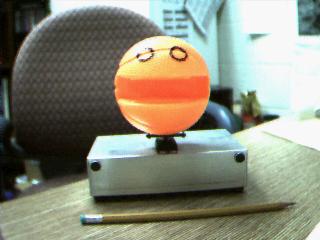 Meet Brooks, the
auditory
localization demo!
Meet Brooks, the
auditory
localization demo!
Brooks (named after Brooks Bishofberger, who did all of the
construction
of the demonstration) is an auditory localization demonstration using
the
barn owl localization chip described elsewhere on this website.
This
system is tuned for 1kHz sounds and uses the plastic orange head
(mounted
on an RCservo) to indicate the computed direction of the sound.
The
two microphones can be seen on the front face of the box.
The Finger!
The Finger started out as a project to study CPGs (central pattern
generators)
in software and quickly became an exercise in programming a 6805 to act
as a parallel processor. The two motors are controlled by a
simulation
of 4 integrate-and-fire neurons which perform a slowly oscillating
pattern
of activity that drives the two motors to drag the whole board forward
on each cycle. When "proprioceptive" feedback coming from the
position
sensors in the servos is fed into the network, the different phases of
the cycle depend on the position of the joint and not the intrinsic
timing
of the network.
RetBot
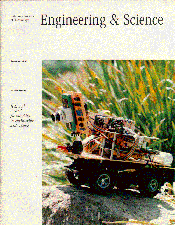
During my super senior year I worked as an undergraduate staff
member
in Christof Koch's lab here at Caltech to build a mobile platform to
demonstrate
the use of the various analog VLSI vision chips being constructed both
in Klab and those from Carverland. In particular this project focused
on
the use of Misha Mahowald and Prof. Carver Mead's Silicon Retina. This
project utilized a 6800 microprocessor (8-bit, 1.2MHz) and used the
retina
chip to drive along lines taped to the floor as well as to pursue small
objects such as cockroaches. The vehicle is approximately 12 inches
long
and has been retired to the Klab Robot Museum. This robot achieved
limited
fame by appearing "curious" on the cover of Caltech's Engineering and
Science
Magazine in the summer of 1990.
RetBot Jr.
Here's a picture
of
my Ph.D. advisor Christof Koch holding one of my robots for a photo in
a
spread
in the Los Angeles Times Magazine. This robot has a silicon retina
mounted
on a rotatable head which is in turn mounted on a toy tank model. This
robot uses the retina to track edges while the head turns to maintain
tracking.
The body, in turn, tries to keep the head centered while moving toward
the edge. This vehicle is only 8 inches long. The processor
on-board
is a 6805 microcontroller.
ASTRO
In the summer of '91 and part of '92, I worked on a project at the
Hughes
Aircraft Malibu Research Labs to build a small mobile robot (named
ASTRO)
which integrates many different sensors to do a surveillance task. The
system consisted of independent sensory and motor modules (each with
their
own microcontroller) which competed for control of which behavior was
active
on the robot. There existed a hierarchy of reflexive behaviors which
served
to prevent the robot from colliding with objects as well as objects
from
colliding with the robot. The final system system constructed from
off-the-shelf
parts consisted of a one-dimensional visual edge tracker, a
pyroelectric
motion detection ring, an auditory localization system, and proximity
sensors.
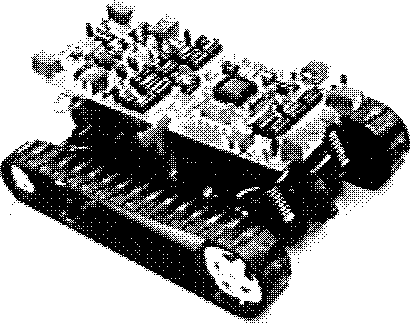
In the badly dithered photo of ASTRO above, the vehicle is
seen
with only the lowest (motor) board attached. The vehicle is
approximately
14 inches long and was constructed from a Tyco radio-controlled
vehicle.
Oh, yeah, ASTRO stands for the Autonomous Surveillance and Tracking
Robot.
Note that I really wanted to name it the Hughes Aircraft Mobile
Surveillance
and Tracking Robot (HAMSTR). Each sensory subsystem board
contained
a 6805 microcontroller performing its local task as if it were an
analog
processor.
Short Movie clip of ASTRO in action
HUMBUG
Humbug was a recreation of ASTRO in the Koch Lab using a more
powerful
RC car, but with fewer sensors.
In 1993 Mrs. Hall's 2nd grade class from an elementary school in
Pasadena
came to visit the robot lab and we played with some of the robots. A
boy
named Sergio made a great drawing of me scaring Humbug with my feet.
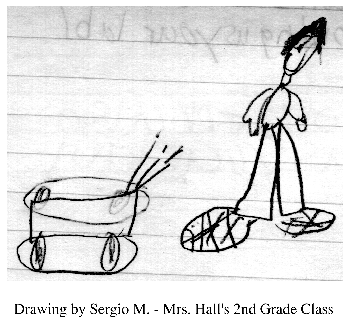
 Meet Brooks, the
auditory
localization demo!
Meet Brooks, the
auditory
localization demo! Meet Brooks, the
auditory
localization demo!
Meet Brooks, the
auditory
localization demo!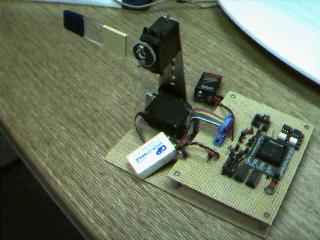 animation1
(1.5MB), animation2
(290KB)
animation1
(1.5MB), animation2
(290KB)
